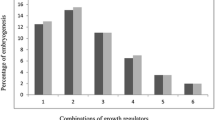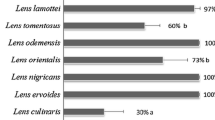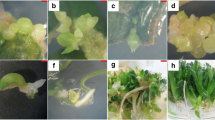Summary
Silks of 18 maize (Zea may L.) F1 hybrids were treated with different combinations of 9 growth regulators, colchicine, and dimethyl sulfoxide (DMSO) for the purpose to induce apomixis (agamospermy) in 1988 and 1989. Hybrid K301 × K303 gave the highest (0.36%) average frequency of seed induction among the hybrids. The most effective treatments were DMSO, gibberellic acid plus 6-benzyl aminopurine (6-BA), and DMSO plus methanesulfonic acid. Individually, the highest frequency of seed induction was 1.4% for hybrid K731×K306 when treated with α-naphthalene acetic acid (NAA)-zeatin mixture. The frequency of seed induction seemed to depend partially on the interaction between chemicals and hybrids. Cytological observation of root-tip cells indicated that the majority of the seeds obtained were diploid, some were mixoploid, and a few were haploid. Diploid plants from induced seeds from the same parent were morphologically uniform and resembled the parent. Variations in plant and ear heights were comparable to those of the hybrid parent. Cytological and morphological investigations suggested that the chemically induced seeds originated mainly from somatic tissue but occasionally came from reduced cells in the embryo sac, leading to haploids. The results showed that chemical induction of adventitious embryony in maize hybrids is possible, but the more effective chemicals, their concentrations, and ways of application for increasing the frequency of seed induction need to be explored for practical use.
Similar content being viewed by others
References
Arenda, N.K., 1976. Variation in the apomictic seedlings of certain species of ficus. In: S.S., Khokhlov. Apomixis and Breeding, pp. 52–63. Amerind Publishing Co. Pvt. Ltd. New Delhi.
Bashaw, E.C. & K.W., Hignight, 1990. Gene transfer in apomictic buffelgrass through fertilization of an unreduced egg. Crop Sci. 30: 571–575.
Belousova, N.I., 1976. Hybridization of maize with tripsacum in relation to the problem of experimental induction of apomixis in maize. In: S.S., Khokhlov. Apomixis and Breeding, pp. 199–204. Amerind Publishing Co. Pvt. Ltd. New Delhi.
Borovskii, M.I., 1976. Apomixis in maize x tripsacum hybrids. In: S.S., Khokhlov. Apomixis and Breeding, pp. 205–207. Amerind Publishing Co. Pvt. Ltd. New Delhi.
Bothmer, R., J., Flink & I., Linde-Laursen, 1986. Complex of interspecific hybridization in barley (Hordeum vulgare L.) and the possible occurrence of apomixis. Theor. Appl. Genei. 76: 681–690.
Brown, W.V., 1972. Apomixis in Cytogenetics. pp. 241–251. The C. V. Mosby company. St. Louis.
Chase, S.S., 1947. Techniques for isolating monoploid maize plants. Amer. J. Bot. 34: 582.
Chase, S.S., 1949. Monoploid frequencies in a commercial double cross hybrid maize and its component single hybrids and inbred lines. Genetics 34: 328–332.
Chase, S.S., 1964. Monoploids and diploids of maize: a comparison of genotypic equivalents. Amer. J. Bot. 51: 928–933.
Chebotar, A.A., 1976. Some cases of apomixis in maize. In: S.S., Khokhlov. Apomixis and Breeding, pp. 102–108. Amerind Publishing Co. Pvt. Ltd. New Delhi.
Coe, E.H., 1959. A line of maize with high haploid frequency. Amer. Nat. 93: 381–382.
Dujardin, M. & W.W., Hanna, 1988. Production of 27-, 28-, and 56-chromosome apomictic hybrid derivatives between pearl millet (2n=14) and Pennisetum squamulatum (2n=54). Euphytica 38: 229–235.
Grishina, E.V. & M.I., Zaitseva, 1976. Dependence of the frequency of haploid formation in maize upon the conditions of pollination and degree of homozygosity. In: S.S., Khokhlov. Apomixis and Breeding, pp. 261–265. Amerind Publishing Co. Pvt. Ltd. New Delhi.
Hanna, W.W. & E.C., Bashaw, 1987. Apomixis: its identification and use in plant breeding. Crop Sci. 27: 1136–1139.
Harlan, J.R. & J.M.J., de, Wet, 1977. Pathways of genetic transfer from Tripsacum to Zea mays. Proc. Nat. Acad. Sci. USA., 74: 3494–3497.
Hermsen, J.G.Th., 1969. Induction of haploids and aneuhaploids in colchicine-induced Solanum chacoene Bitt. Euphytica 18: 183–189.
Kontezuma-de-Carvalha, J., 1967. The effect of N2O on pollen tube mitosis and its potential significance for inducing haploidy in potato. Euphytica 16: 190–198.
Laikova, L.I., 1976. Cytoembryological findings about autonomous formation of endosperm in maize. In: S.S., Khokhlov. Apomixis and Breeding, pp. 109–112. Amerind Publishing Co. Pvt. Ltd. New Delhi.
Li, M.D., 1983. Study of chemical induction of apomixis in maize. Gansu-Agri. Sci. 8: 16–19. (In Chinese).
Murty, U.R., P.B., Kirti, M., Bharathi & N.G.P., Rao, 1984. The nature of apomixis and its utilization in production of hybrids (‘vybrids’) in Sorghum bicolor (L.). Moench Pflanzenzuecht 92: 30–39.
Petrov, D.F., 1976. Genetically regulated apomixis as a method of fixing heterosis and its significance in breeding. In: S.S., Khokhlov. Apomixis and Breeding, pp. 18–28. Amerind Publishing Co. Pvt. Ltd. New Delhi.
Ustinova, E.I., 1976. Apomixis in sunflower. In: S.S., Khokhlov. Apomixis and Breeding, pp. 113–119. Amerind Publishing Co. Pvt. Ltd. New Delhi.
Voigt, P.W., 1984. Breeding apomictic lovegrass: Forage potential of Boer x Weeping hybrids. Crop Sci. 24: 115–118.
Winkler, H., 1908. Über Parthenogenesis und Apogamie im Pflanzenreiche. Ztschr. f. Botanik, 8.
Yudin, B.F., 1966. Experimental induction of marked polyploids in maize and problem in apomixis. Soveshchanie po problemam apomiksisa u Rastenii Tezisy Dokl. Izd. Saratovsk. Gos. Univ.
Zhao, Z. & M., Gu, 1984. Production of diploid pure lines of maize through parthenogenesis induced by chemicals. Acta Genet. Sin. 11: 39–46.
Zhao, Z. & M., Gu, 1988. Cytogenetic study of chemical induced parthenogenic maize plants. Acta Genet. Sin. 25: 89–94.
Zhou, S., 1980. A preliminary study on parthenogenesis in cotton. Acta Genet. Sin. 7: 247–256.
Author information
Authors and Affiliations
Rights and permissions
About this article
Cite this article
Hu, G., Liang, G.H. & Wassom, C.E. Chemical induction of apomictic seed formation in maize. Euphytica 56, 97–105 (1991). https://doi.org/10.1007/BF00042052
Received:
Accepted:
Issue Date:
DOI: https://doi.org/10.1007/BF00042052




